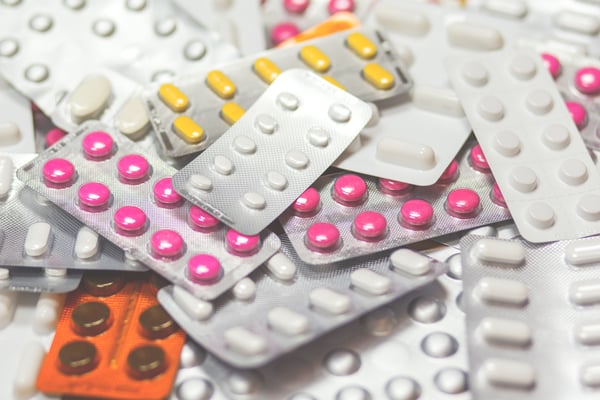Share this
Guide to Blister Pack Packaging Adhesives
by Luminite on Oct 4, 2019 11:11:00 AM

Blister packs are a large and rapidly expanding segment of the global packaging industry. They let consumers see what's inside and reduce tampering, while protecting the product itself from environmental factors, mishandling, and even animals. Blister packaging adhesives are now used for everything from prescription medications and batteries to toys, hardware, electronic goods, and more.
Since it is becoming so popular, let’s take some time and focus on what you need to know about printing blister packaging.
How Blister Packaging Adhesives Are Put Together
In its most basic form, a blister pack usually consists of some type of pre-formed plastic, which encases the product and some type of backing. The plastic is then adhered to the backing.
Along the way, however, there can be many variables that affect the decisions you make. Material for the blister might be a thermoplastic polymer resin, such as PVC (polyvinyl chloride) or PET (polyethylene terephthalate).
The blister card, or backing, might consist of:
- Cardboard
- Plastic
- Aluminum Foil
The card or backing usually contains some printing or graphics to draw attention to the item inside. The blister is then affixed to the backing using some type of hot melt adhesive that is activated by heat and pressure, but cold seal may also be used.
Can the Flexographic Printing Process Be Used for Blister Pack Production?
Flexographic printing opens myriad opportunities for the blister pack industry. Flexo is effective at printing a wide variety substrates, which accommodate the various materials used in blister packs.
The one concern to keep in mind is that inks used for printing should be free of ingredients that might compromise the adhesion process, and may need to be heat-tolerant.
Adhesives That Can Be Used in Blister Packaging
Since adhesives used in blister packaging are involved in high-speed production processes, they must be flexible, bond rapidly, cure quickly and stay transparent.
Adhesive options may include water-based, solvent-based, and epoxy blends.
Considerations in choosing the appropriate adhesive include:
- Materials being bonded
- Sealing method
- Adhesive weight
- Adhesive activation temperature
- Drying time required before stacking
- Storage and shipping conditions
- Weight of product
- Negative interactions with product
Adhesive Transfer 101
The adhesive can be laid down with the use of sleeves, cylinders, or plates. Cylinders are ideal for hot adhesive applications, due to the ease of heating them. Sleeves can be used as well, provided they have a nickel core. If using cold seal, fiberglass core sleeves and plates are appropriate.
Regardless of your image carrier type, silicone elastomer is likely the best material option when using adhseives -- due to both its release characteristics and its ability to tolerate high heat.
Challenges When Printing Blister Packaging
As always challenges can arise, such as adhesive build-up, thermal expansion, clean-up problems, and other mishaps. An experienced elastomer sleeve and plate supplier can help ease the process.
Editor's Note: This blog post was originally published on July 10, 2018 and was republished on October 4, 2019 to reflect updated insight and resources.
Share this
- Flexographic Printing (81)
- Image Carrier (28)
- Elastomer sleeves (27)
- Ink Transfer (25)
- Quality (22)
- Flexo sleeve (20)
- News (18)
- printing defects (18)
- flexo printing defects (17)
- sustainability (13)
- Flexo Troubleshooting (12)
- Ink (12)
- Digital Printing (10)
- Flexo 101 (10)
- Flexo Inks, (9)
- Anilox (7)
- Blister Packaging (7)
- Cost (6)
- print misregistration (6)
- regulations (6)
- Corrugated Printing (4)
- pinholing (4)
- "Tradeshow (3)
- Digital Flexo (3)
- Gravure Printing (3)
- Insider (3)
- Load-N-Lok (3)
- Wide Web (3)
- direct laser engraving (3)
- flexo-equipment-accessories (3)
- gear marks (3)
- halo (3)
- testing (3)
- Narrow Web (2)
- bridging (2)
- feathering (2)
- filling in (2)
- mottled image (2)
- pressure (2)
- Labelexpo (1)
- dirty prints (1)
- doughnuts (1)
- embossing (1)
- kiss impression (1)
- October 2023 (2)
- September 2023 (1)
- August 2023 (1)
- July 2023 (3)
- June 2023 (1)
- May 2023 (5)
- April 2023 (1)
- March 2023 (2)
- February 2023 (1)
- January 2023 (3)
- December 2022 (1)
- October 2022 (3)
- September 2022 (2)
- August 2022 (2)
- July 2022 (3)
- May 2022 (1)
- April 2022 (4)
- March 2022 (2)
- February 2022 (5)
- January 2022 (7)
- December 2021 (1)
- November 2021 (3)
- October 2021 (2)
- September 2021 (1)
- August 2021 (1)
- July 2021 (3)
- June 2021 (1)
- May 2021 (4)
- April 2021 (4)
- March 2021 (4)
- February 2021 (2)
- December 2020 (1)
- November 2020 (1)
- October 2020 (2)
- September 2020 (1)
- August 2020 (3)
- July 2020 (2)
- June 2020 (3)
- May 2020 (1)
- April 2020 (1)
- November 2019 (3)
- October 2019 (1)
- August 2019 (1)
- July 2019 (1)
- April 2019 (1)
- March 2019 (1)
- January 2019 (1)
- October 2018 (2)
- August 2018 (1)
- July 2018 (1)
- June 2018 (1)
- February 2018 (2)
- October 2017 (1)
- September 2017 (2)
- January 2016 (1)
- February 2015 (1)
- January 2015 (1)
- December 2014 (2)
- September 2014 (1)
- February 2014 (1)
- January 2014 (1)
- December 2013 (3)
- October 2013 (1)
- September 2013 (1)
- June 2013 (1)
- January 2013 (1)


Comments (7)